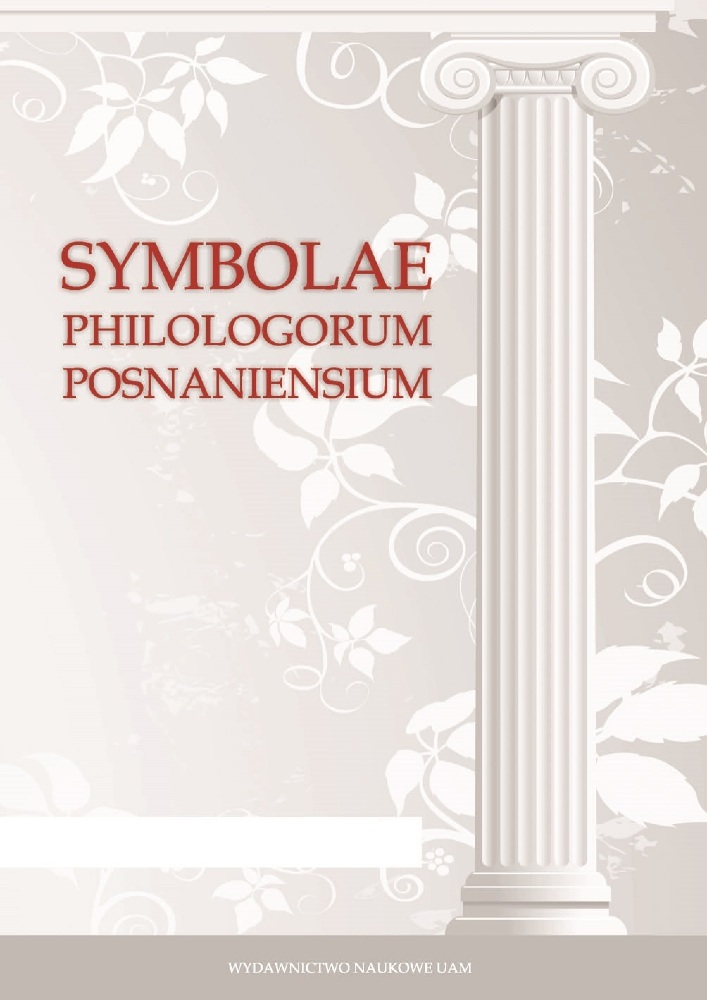Abstrakt
The present article discusses selected examples of the poetic means which Seneca uses in order to achieve the effect of synaesthesia in his tragedies. An analysis of these examples reveals that the poet makes the most of the Latin language’s semantic and musical potential and in doing so achieves quite spectacular sensory effects.
Bibliografia
Primary sources
Braund 2016: S. Braund, Seneca: Oedipus, London-New York, 2016.
Boyle 2014: A. J. Boyle (ed. with a comm.), Seneca, Medea, Oxford 2014.
Coffey and Mayer 1990: M. Coffey and R. Mayer (eds.), Seneca, Phaedra, Cambridge, 1990.
Fitch 2002: J. Fitch (ed. with a transl.), Seneca, Tragedies, Volume I: Hercules, Trojan Women, Phoenician Women, Medea, Phaedra, Cambridge MA, 2002.
Fitch 2004: J. Fitch (ed. and trans.), Seneca. Tragedies, Volume II: Oedipus, Agamemnon, Thyestes, Hercules on Oeta, Octavia, Cambridge MA, 2004.
Keulen 2001: A. J. Keulen (ed. with a comm.), L. Annaeus Seneca, Troades, Leiden-Boston-Köln, 2001.
Mayer 2002: R. Mayer, Seneca: Phaedra, London 2002.
Rudd 2004: N. Rudd (trans.), Horace. Odes and Epodes, Cambridge MA 2004.
Rushton Fairclough 1918: H. Rushton Fairclough, Virgil, Aeneid: Books 7–12. Appendix Vergiliana, Cambridge MA, 1918.
Showerman 1914: G. Showerman (trans.), Ovid, Heroides. Amores, Cambridge MA, 1914.
Wheeler 1924: A. L. Wheeler (transl.), Ovid, Tristia. Ex Ponto, Cambridge MA, 1924.
Secondary sources
Baertschi 2016: M. Baertschi, “Epic Elements in Senecan Tragedy,” in: G. W. M. Harrison (ed.),
Brill’s Companion to Roman Tragedy, Boston-Leiden 2016, 171–95.
Bellandi 2010: F. Bellandi, “La sposa, la porpora e le luci dell’alba (a proposito di Seneca, Medea 99–101),” Hermes 138 (2010), 487–93.
Bettini 1984: M. Bettini, “Lettura divinatoria di un incesto (Seneca Oed. 366 ss.),” MD 12 (1984), 145–59.
Bradley 2013: M. Bradley, Colour as a Synaesthetic Experience in Antiquity, in: S. Butler and A. Purves (eds.), Synesthesia and the Ancient Senses, Oxford-London 2013, 127–40.
Bradley 2016: M. Bradley (ed.), Smell and the Ancient Senses, Oxford 2016.
Butler and Purves 2013: S. Butler and A. Purves (eds.), Synesthesia and the Ancient Senses, Oxford-London 2013.
Friedrich 2002: A. Friedrich, Das Symposium der “XII sapientes”. Kommentar und Verfasserfrage, Berlin-New York 2002.
Gunderson 2015: E. Gunderson, The Sublime Seneca. Ethics, Literature, Metaphysics, Cambridge 2015.
Highet 1974: G. Highet, “Consonant Clashes in Latin Poetry,” CPh 69 (1974), 178–85.
Jakobi 1988: R. Jakobi, Der Einfluss Ovids auf den Tragiker Seneca, Berlin-New York 1988.
Kent 1910: R. G. Kent, “Haec ubi dicta agrestem pepulere, Horace, Sat. II, 6, 97–98,” TAPhA 41 (1910), xlv-vi.
Kohn 2012: T. D. Kohn, The Dramaturgy of Senecan Tragedy, Ann Arbor 2012.
Mastronarde 1970: D. Mastronarde, “Seneca’s Oedipus: The Drama in the Word,” TAPhA 101 (1970), 291–315.
McCabe 1993: R. A. McCabe, Incest, Drama and Nature’s Law 1550–1700, Cambridge 1993.
McGill 2005: S. McGill, Virgil Recomposed. The Mythological and Secular Centos in Antiquity, Oxford 2005.
Perutelli 1989: A. Perutelli, “Il primo coro della Medea di Seneca,” MD 23 (1989), 99–117.
Rees 1994: R. Rees, “Common Sense in Catullus 64,” AJPh 115 (1994), 75–88.
Schmitz 1993: Ch. Schmitz, Die Kosmische Dimension in den Tragödien Senecas, Berlin-New York 1993.
Segal 1977: Ch. Segal, “Synaesthesia in Sophocles,” ICS 2 (1977), 88–96.
Sklenář 2008: R. Sklenář, “Oedipus 980–94: How Stoic a Chorus?,” CJ 103 (2008), 183–94.
Slaney 2016: E. Slaney, The Senecan Aesthetic. A Performance History, Oxford 2016.
Squire 2016: M. Squire (ed.), Sight and the Ancient Senses, Oxford 2016.
Stevens 2008: B. Stevens, “The Scent of Language and Social Synaesthesia at Rome,” CW 101 (2008), 159–71.
Trinacity 2007: Ch. V. Trinacity, “Seneca’s Heroides: Elegy in Seneca’s Medea,” CJ 103 (2007), 63–78.
Trinacity 2014: Ch. V. Trinacity, Senecan Tragedy and the Reception of Augustan Poetry, Oxford-New York 2014.
Tupper 1917: F. Tupper, “The Envy Theme in Prologues and Epilogues,” The Journal of English and Germanic Philology 16 (1917), 551–72.
Volk 2013: K. Volk, “Manilius’ Cosmos of the Senses,” in: S. Butler and A. Purves (eds.), Synesthesia and the Ancient Senses, Oxford-London 2013, 103–114.
Walter 2013: B. Walter, “Reading Death and the Senses in Lucan and Lucretius,” in: S. Butler and A. Purves (eds.), Synesthesia and the Ancient Senses, Oxford-London 2013, 115–125.
Williams 1996: S. Williams, The Function of the Monster in Mediaeval Thought and Literature, Montreal and Kingston 1996.
Wilson 2010: M. Wilson, Rhetoric and the Younger Seneca, in: W. Dominik and J. Hall (eds.), A Companion to Roman Rhetoric, Oxford 2010, 425–38.
Licencja
